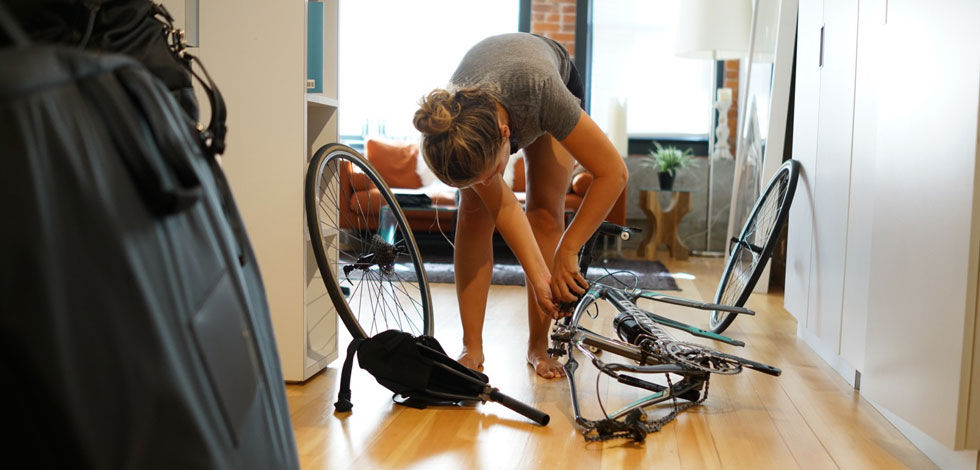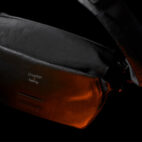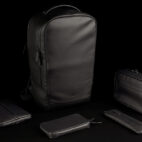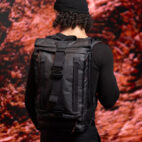How to Fly With a Bike: 8 Things to Know
Cyclists, if you’ve ever daydreamed about touring through France or spending a week mountain biking the trails in Whistler, you may have thought about whether or not you can fly with a bike. The answer is yes – though flying with a bike is different than flying with a regular piece of travel luggage.
While flying with a bike is more of a hassle, it’s not that bad if you know what to expect, how to prepare, and a few tips and tricks to make it less logistically complicated. And, once you put your bike together and leave the airport, you’re sure to have a unique adventure you’ll never forget. Worth it.
1. Get the Right Bike Case for Flying
Sorry, but packing your bike doesn’t usually mean breaking out your largest suitcase (though it’s been done). To fly with your bike, you’ll need a bike case, of which there are three types: hard case, soft case, and cardboard box.
A hard case will do the best job of protecting your bike, but they can be heavy. A soft case is usually less protective but much easier to store and lighter in weight. Both of these options are pricey, with good-quality bike boxes costing at least a few hundred dollars new. The cheapest, but least protective, option is a cardboard box. This is a good option if you’re on a budget and don’t have a crazy nice bike, or just want a box you can ditch when you’re done with it.
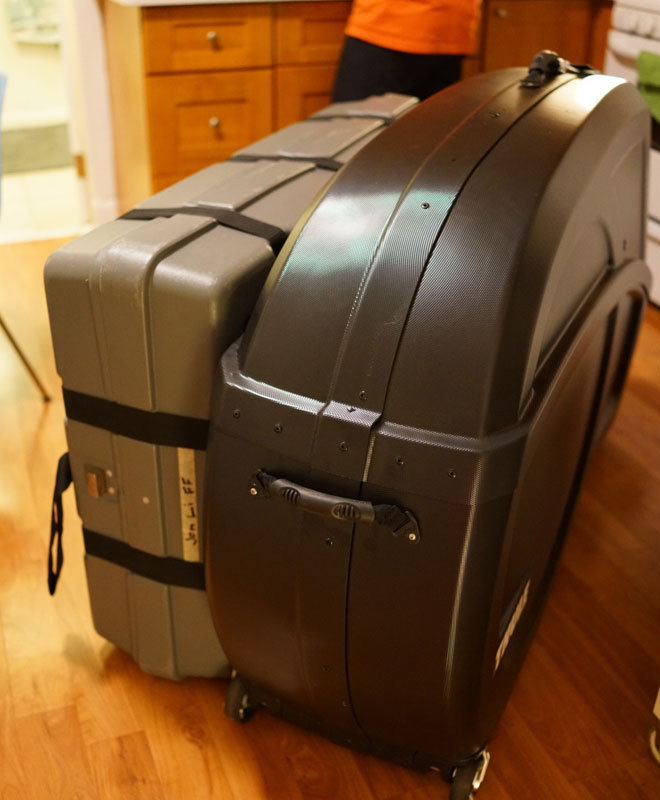
Suggested bike boxes for air travel
Cardboard bike box: These are typically free from your local bike shop, though some may charge $5-10. You can also buy one for $40 from Bike Flights.
Thule RoundTrip Pro XT Bike Case ($600): Sturdy, protective, and well-loved by serious cyclists, the Thule RoundTrip will keep your road, mountain, or cross bike safe en route, and is spacious enough to fit just about any non-tandem bike. The only downside, though, is it’s unnecessarily large for 53cm frames and smaller. Fellow shorties, you’ve been warned. Same goes for its (heavier) hard case counterpart, the Thule RoundTrip Transition Bike Case ($600).
Evoc Bike Travel Bag ($424): Similar to the Thule RoundTrip, the Evoc is a soft case with structure that protects your bike well, and is large enough that you don’t have to disassemble everything. It’s also lighter-weight, which is helpful if you’re traveling with a bike.
The Airport Ninja by Orucase ($500): Orucase’s Airport Ninja bills itself as the “world’s smallest bike case,” and in comparison to Thule and Evoc it’s definitely smaller. I found it a lot easier to fit in a regular taxi (versus a minivan) and store, but the smaller size meant I had to break down my bike more than with the Thule/Evoc, and I definitely didn’t fool anyone into thinking there was something other than a bike in there. Regardless, it’s a good, more compact option for road bikes.
Before you choose your bike box, you should also check your airline’s requirements for traveling with a bike. Some have specific instructions on which type of case to use.
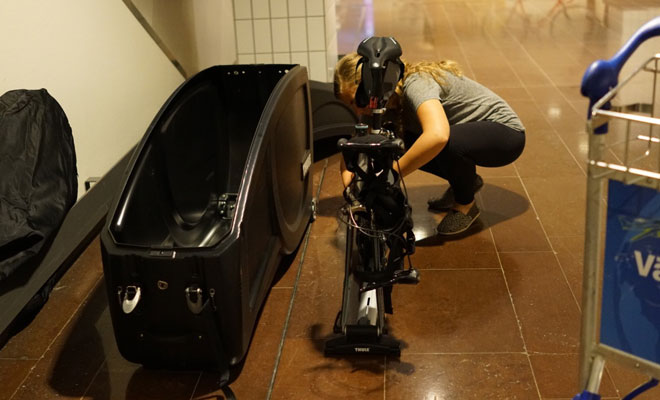
2. Know How to Put Your Bike in a Case — And Pack the Right Tools
Now that you’ve gotten your bike case, how do you get it in there? To start, grab the following tools:
- A pedal spanner (or wrench) to take your pedals off
- A set of allen keys to disassemble your seatpost, handlebars, and pretty much everything else
- Extra padding if you want to be extra protective against scratches and dings on your frame
While all bikes and boxes are a little different, your next step is to take your bike apart to put in the box. To do this, you’ll do roughly the following:
- Put your bike on your smallest gears.
- Remove your seatpost and saddle. You can also mark your seatpost before you do this, so you know exactly where to replace it later.
- Remove your pedals. Some will need a pedal spanner, some can be removed with an allen key.
- Loosen your stem bolt so that your fork moves freely, and you can take your handlebars off the stem and angle them parallel to the frame.
- Remove your wheels and take the quick releases out of the wheels. Make sure you keep track of the small springs on the quick release. Most bike boxes will have a small pocket for this.
- Next, put your bike in the box. Depending on your bike box, you’ll start by attaching the frame to the box, then adding in the wheels. You’ll place all smaller parts and accessories in last. Your handlebars usually sit flat against the frame.
- Add any additional padding you might need (for example, extra padding around your fork).
For more instructions, I’d recommend looking up instructions specific to your bike box or, if you can’t find them, follow the lead of Global Cycling Network’s pros and watch one of their videos. How to pack a bike box is a good general overview. If you’re using a cardboard box, take a look at their video on packing cardboard boxes.
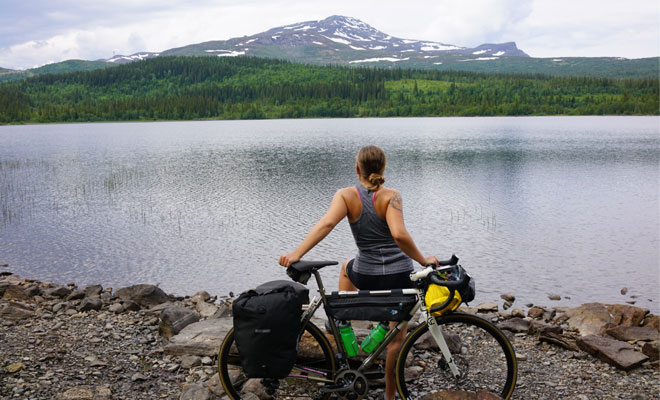
3. Touring? Have a Plan for Storing, Shipping, or Ditching Your Box
If you’re flying with your bike to tour (versus staying in one place and racing, for example), you’ll need a plan for what you’re going to do with your bike box. Choose one of the following:
Ditch it: If you’ve chosen to travel with a cardboard box, simply recycle it and plan to get a new one later.
Store it: Hotels and hostels will usually let you store them in their luggage rooms if you’ve stayed a night there. Just make sure to contact your hotel in advance to double check. Outside of the U.S., airports and train stations often have long-term luggage storage where you can pay to store your bag. Usually, you pay based on the size of your bag and the length of time you need to store it for.
Ship it: If you’re ending your trip somewhere other than where you started, ship your box to the end of your route. Usually, hotels will receive a package on your behalf but you’ll have to book a room there and should call in advance to check and notify them that you’ll be expecting a package.
4. Pack Carry-On Only for Your Other Luggage
When I first flew with a bike, one unexpected consideration I encountered was how I’d pack everything else. Especially since I would already be lugging around a giant bike case, I knew packing carry-on only would be even more important. However, with the extra bike gear, it’s a little more challenging than usual. Here are some tips to keep your packing list light while flying with a bike:
– A carry-on sized backpack is best, since you’ll likely be dragging a bike box. My favorites are Tortuga’s Setout Divide and Osprey’s Talon 22L. A few other Carryology favorites include the GORUCK GR2 and the Trakke Storr.
– Limit yourself to 10 items of clothing and 1-2 pairs of street shoes.
– Choose items that are lightweight and pack down small.
– Bring travel-sized toiletries only – especially if you’re bike touring. humangear has great refillable containers to help you keep your liquids to a minimum.
– Use compression sacks to minimize the size of your clothes (I like Eagle Creek’s).
– Limit your electronics to just the essentials. For me that’s a phone, camera, headphones, small external battery, and chargers.
Packing light can be a challenge, but you’ll thank yourself later if you only have one piece of unusually large luggage to travel with.
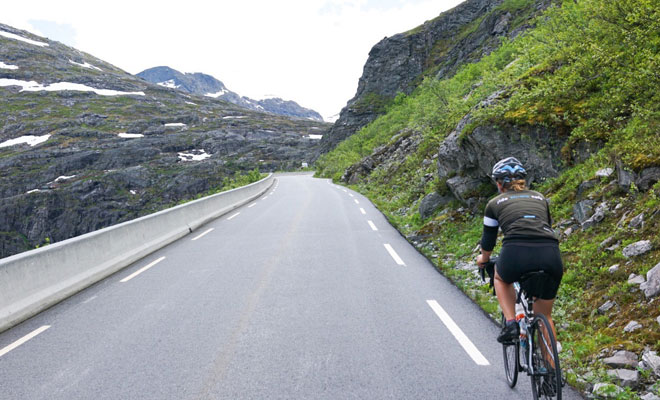
5. Additional Things to Pack When Traveling With a Bike
Traveling with a bike requires packing a few more things than normal – besides your bike (obviously). As long as it doesn’t send me over the weight limit, I’ll almost always pack all of these items (minus the clothing) in my bike box:
- Helmet
- Bike shoes
- 2 bike kits (shorts and jersey)
- Spare tubes
- Lever
- Patch kit
- Mini hand pump
- Allen key and pedal spanner
- Water bottles (keep these in your water cages)
If you’re bike touring and need panniers or frame bags, I’d recommend checking out Porcelain Rocket for some nifty under seat, handlebar, and frame bags.
6. Plan to Get Slammed With a Bike Fee by Your Airline
The first time I flew with a bike, I went with Virgin America (RIP) from San Francisco to Seattle. They charged us the normal $25 bag fee and treated it like any other luggage. It was surprisingly easy, and I – incorrectly – thought flying with a bike would always be like that. What I didn’t know was Virgin/Alaska are one of the most bike-friendly airlines and are more relaxed than most.
Fast-forward one year, when my boyfriend and I brought our bikes on a United flight from San Francisco to Stockholm for a two-week, 700-mile tour of Scandinavia. We were slapped with a $200 fee (each!) for the bikes — even though a normal suitcase of the same weight would have been free on an international flight like that. Ouch. Before you book your flight, make sure you take into consideration the wildly varied fees on top of the fares **:
| Airline | Normal checked bag fee (for economy) | Fee for bikes |
| United | $25 | $150 domestic; $200 international |
| Alaska Airlines | $25 | $25 |
| Air Canada | $28.75 | $87.75
(Checked bag fee + a $59 handling fee) |
| American Airlines | $25 | $150 |
| Qantas Australia | First bag free | Free within Australia (so long as it’s within the weight limit and you don’t check a second bag) |
| British Airways | First bag free | Supposed to count as your one checked bag. If overweight, expect to pay up $60-$100 |
| Air New Zealand | First bag free | $52 within NZ, $112 to Australia, $165 for rest of world for oversized / overweight luggage |
| Aer Lingus | $22-57, depending on destination. | $57 (you must call in advance to reserve a spot for your bike; each flight limited to 10 bikes per flight) |
| Ryanair | $50 | $68 if booked online; $85 at the airport |
| Singapore Airlines | First two bags free | Counts as a piece of luggage, but fees of $50-225 apply for oversized / overweight luggage |
| Jetblue | $25 | $50 ** Extra restrictions on some routes |
| Jetstar | Free on most fares | $9-25 USD |
| Frontier | $45 | $75 |
| Southwest | First two bags free | $75 |
| Delta | $25 | $150 |
** All fees in USD
7. There Are Ways to Avoid Bike Fees
The best way to avoid overpaying to bring your bike on a flight is to choose the right airline, but you can also use some of the workarounds for paying for checked luggage on certain airlines. Most airlines will give you a bit of leeway if you:
- Have their credit card. Most airlines allow a free checked bag as a cardholder benefit. If you pay with their credit card, you might also be able to negotiate with your credit card company to remove the charge after the fact.
- Fly first or business class. Hey, if you’re going to pay more, you might as well get more, right?
- Don’t say it’s a bike. You can always play the game of chance and try to get away with pretending like there isn’t a bike in your bike box. The one time I got away with it, I paid for my “checked bag” at a kiosk, then went to drop it off.
8. Flying With Your Bike isn’t The Only Way to Bike and Travel
While flying with your bike is possible and it’s always nice to have your own fitted, trusted, and loved bike when you’re adventuring, it’s not always the easiest or most affordable option.
If you want to have your bike, but skip the hassle of dragging it to and from the airport, you could ship your bike a couple of days before your flight. BikeFlights is a company specializing in shipping bikes, and is a pretty good deal domestically. However, their international fees are on par with even the highest of airline fees.
Regardless, they can help you out better than a normal shipping service like FedEx (which also ships bikes). Make sure to insure your bike and track your package if you decide to ship it.
Finally, you can also opt to rent a bike at your destination. If you’re doing any serious cycling, skip the usual tourist bike kiosks and search for a bike store that will rent out or demo quality road, mountain, or tandem bikes. Most bike shops who rent will give discounts for long-term rentals and provide additional gear, such as tools, spare tubes, and even helmets. If you plan to rent, you should still bring your own shoes, kits, and lights. I also prefer to bring my own helmet.
Before deciding to rent, weigh the cost effectiveness of it. For example, when my partner and I spent a week road tripping in Spain and France, we decided we wanted to spend three days cycling while we watched the Tour de France. For a bike rental in Spain, it only cost us $90 for the three days — far cheaper and less hassle than it would have been to check our own bikes with United.
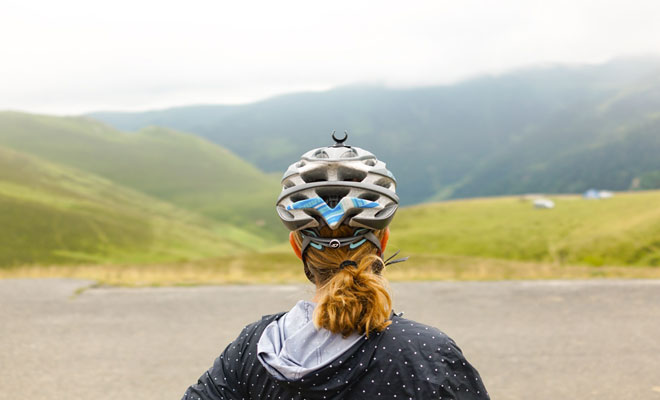
Where Will You Bike?
While flying with a bike may be a bit of a chore, traveling by bike can unlock some really special adventures. And like anything, the more you do it, the better you’ll get at it. Now that you know how to fly with a bike, what roads will you explore?





 Carry Awards
Carry Awards Insights
Insights Liking
Liking Projects
Projects Interviews
Interviews
